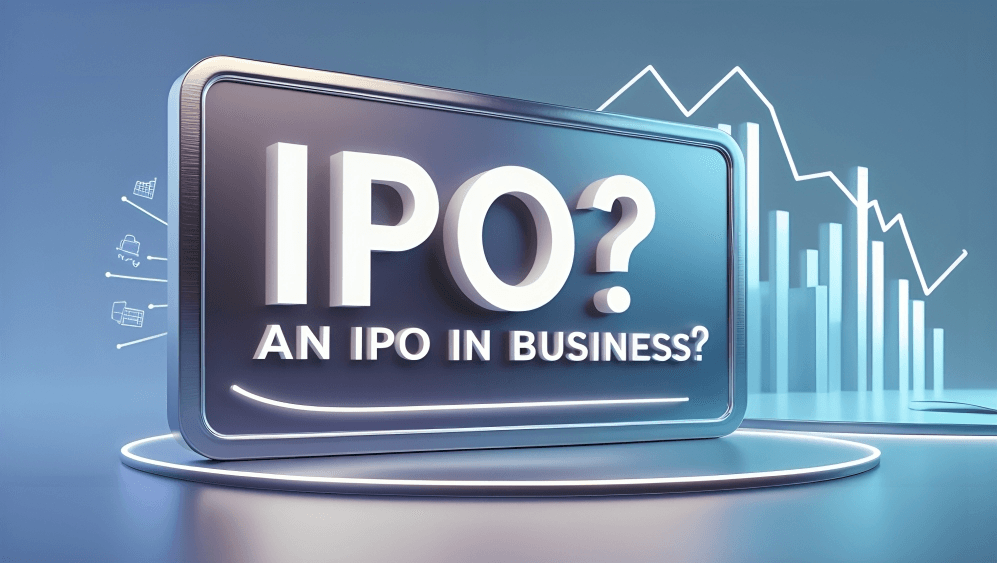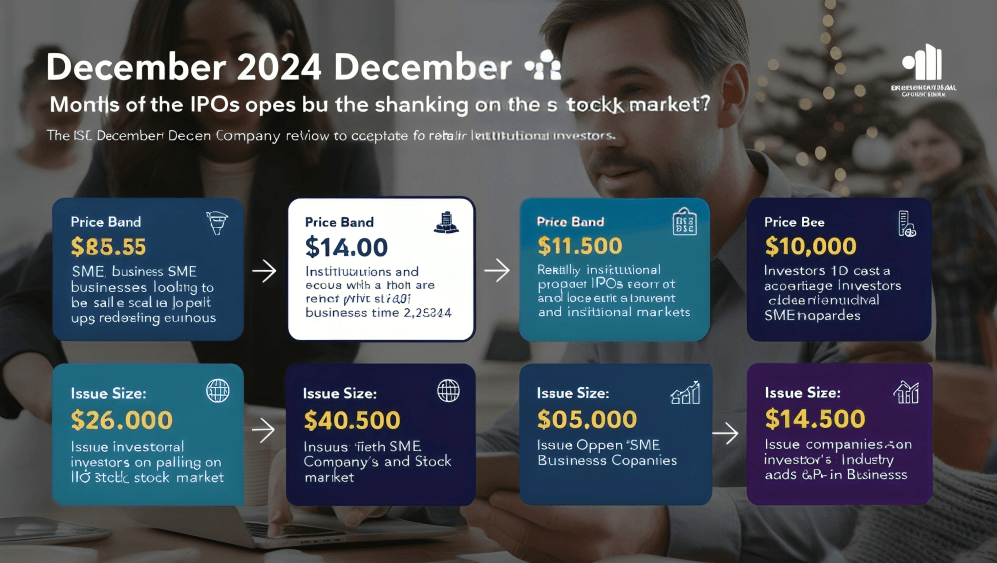An IPO marks a company’s transition from private to public, allowing it to raise capital through the sale of shares. This article delves into the IPO process, the motivations behind going public, its impact on businesses, and how investors can benefit from participating in these offerings.
What is an IPO in Business? Understanding the Process, Benefits, and Risks

An Initial Public Offering (IPO) is a significant milestone for businesses seeking to expand and access larger pools of capital. Simply put, an IPO is the process through which a private company offers its shares to the public for the first time. This transformation from a private entity to a publicly traded company marks its entry into the stock market.
The “What is an IPO in Business” often arises among investors and entrepreneurs who want to understand how companies grow by going public. The process enables companies to raise funds to support operations, invest in growth, or pay off debts. Once listed, the company’s shares are traded on stock exchanges such as NASDAQ or the New York Stock Exchange (NYSE) in the USA.
The Key Components of an IPO
To fully understand what an IPO in business means, it’s essential to break it down into its core components:
- Shares and Equity:
- When a company initiates an IPO, it divides ownership into smaller portions known as shares. These shares are sold to investors, who become partial company owners.
- Public Offering:
- This refers to making shares available to the general public, including individual and institutional investors.
Curious about upcoming IPOs? Read our latest post on Upcoming IPOs in 2025.,
If you’re looking for investment tips related to IPOs, visit How to Invest in IPOs:
Step-by-Step Guide for Small Investors and Beginners
Why IPOs Are Important in Business
The question, “What is an IPO in business?” often leads to understanding its importance for companies and the economy:
- For Businesses: IPOs provide funds, enabling companies to grow rapidly.
- For Investors: IPOs allow investors to participate in a company’s growth journey and earn potential returns.
- For the Economy: IPOs encourage market activity, innovation, and job creation.
Understanding the Basics of an IPO
Definition of an IPO
An Initial Public Offering (IPO) is the process by which a privately held company offers its shares to the public for the first time. This transition from private to public ownership allows the company to raise capital from a broader pool of investors. By listing on a stock exchange, the company gains access to public funds, which can be utilized for various purposes such as expansion, debt reduction, or research and development.
When asking what is an IPO in business, it is important to understand that the significance of an IPO goes beyond just fundraising.
The significance of an IPO in the business world is multifaceted:
- Capital Generation: An IPO provides companies with substantial funds to finance growth initiatives, acquisitions, or debt repayment.
- Market Visibility: Becoming publicly traded enhances a company’s profile, potentially attracting new customers, partners, and employees.
- Liquidity for Shareholders: An IPO offers existing shareholders, including founders and early investors, an opportunity to monetize their holdings.
- Valuation Benchmark: The public listing establishes a market-driven valuation, reflecting investor sentiment and company performance.
Thus, what is an IPO in business can be defined not just as a financial transaction but as a pivotal event that sets a company on a new trajectory.
The Process of How an IPO Works
The process of making a company public, often referred to as an IPO, involves several key steps. Understanding these steps is essential when trying to comprehend what is an IPO in business and how it works in practice:
- Preparation and Due Diligence:
- The company collaborates with financial advisors, legal experts, and auditors to prepare necessary documentation, including financial statements and business disclosures. A comprehensive due diligence process is conducted to ensure all information is accurate and complies with regulatory standards.
- Filing with Regulatory Authorities:
- The company submits a registration statement, such as the S-1 form in the United States, to the Securities and Exchange Commission (SEC). This document provides detailed information about the company’s operations, financials, and risks. This is a critical part of answering what is an IPO in business, as it ensures transparency and investor protection.
- Marketing the IPO (Roadshow):
- Company executives and underwriters embark on a “roadshow,” presenting the investment opportunity to potential institutional investors. This phase is crucial for generating interest and gauging demand for the IPO, which helps determine the final price.
- Pricing the IPO:
- Based on investor feedback and market conditions, the company and its underwriters set the IPO price, determining the amount of capital to be raised and the initial share price. Understanding what is an IPO in business also means recognizing that pricing plays a significant role in a company’s ability to succeed in the public markets.
- Going Public:
- On the designated date, the company’s shares are listed on a stock exchange, and trading commences. The company becomes subject to public reporting requirements and increased regulatory scrutiny. This is when the company transitions into the public realm, fulfilling the core objective of what is an IPO in business to raise capital and gain broader market recognition.
Example:
Consider a technology startup, “TechInnovate,” that has developed a groundbreaking software solution. To accelerate growth and expand its market reach, TechInnovate has decided to go public. The company partners with investment banks to navigate the IPO process conducts a roadshow to attract investors, and successfully lists its shares on the New York Stock Exchange (NYSE). Post-IPO, TechInnovate utilizes the raised capital to enhance product development and enter new markets, While also benefiting from increased brand recognition and credibility in the industry.
By understanding what is an IPO in business, both companies and investors can make informed decisions regarding IPO participation, which ultimately shapes the future of the company and the market at large.
Why Do Businesses Opt for an IPO?
An Initial Public Offering (IPO) is a significant milestone for any company, marking its transition from private to public ownership. This strategic move offers various financial and strategic advantages, as well as certain challenges. Understanding what is an IPO in business is crucial for comprehending why companies choose this route.
Reasons for Going Public
- Raising Capital:
- Funding Growth and Expansion: By issuing shares to the public, companies can secure substantial capital to finance expansion plans, research and development, and other growth initiatives. This influx of funds can be pivotal for scaling operations and entering new markets. Understanding what is an IPO in business allows stakeholders to better appreciate how it provides the financial boost necessary for business expansion. (tipalti.com)
- Debt Reduction: The capital raised through an IPO can be utilized to pay down existing debts, thereby improving the company’s balance sheet and reducing interest expenses. This financial restructuring can enhance profitability and financial stability. If you’re exploring what is an IPO in business, understanding the role of debt management is essential. (investopedia.com)
- Enhancing Liquidity and Marketability of Shares:
- Facilitating Share Trading: Publicly traded shares can be easily bought and sold on stock exchanges, providing liquidity for shareholders. This liquidity is attractive to investors and can make the company’s stock more appealing. Learning what is an IPO in business involves understanding how it increases liquidity and market accessibility for company shares. (almondztrade.com)
- Attracting and Retaining Talent: Public companies can offer stock options and other equity-based compensation to employees, which can be a powerful tool for attracting and retaining top talent. This aligns employees’ interests with the company’s performance and growth. Knowing what is an IPO in business helps grasp how it plays a crucial role in talent management. (sec.gov)
- Increasing Brand Recognition and Prestige:
- Boosting Public Profile: An IPO can significantly raise a company’s profile, leading to increased brand recognition and credibility in the market. This enhanced visibility can attract new customers, partners, and investors. Understanding what is an IPO in business is key to appreciating how it boosts a company’s standing in the competitive market. (onboardmeetings.com)
- Access to a Broader Investor Base: Going public opens up the company to a wider range of investors, including institutional investors, which can provide more stability and support for the company’s stock price. This explains what is an IPO in business and how it expands the pool of potential investors. (inc.com)
Benefits and Challenges of an IPO
Benefits:
- Access to Capital:
- Funding for Expansion: The capital raised through an IPO can be used for various purposes, including funding mergers and acquisitions, entering new markets, and investing in new technologies. This financial flexibility can accelerate the company’s growth trajectory. Grasping what is an IPO in business is essential for understanding its potential to fuel significant business expansion. (tipalti.com)
- Improved Financial Position: A successful IPO can enhance the company’s financial position, making it easier to obtain financing in the future and potentially at more favorable terms. This improved financial standing can be advantageous in negotiations with creditors and investors. It highlights how what is an IPO in business directly influences a company’s financial outlook. (investopedia.com)
- Increased Credibility and Visibility:
- Enhanced Market Perception: Being listed on a public exchange can enhance a company’s credibility, making it more attractive to customers, suppliers, and potential business partners. This increased trust can lead to better business opportunities and partnerships. To fully understand what is an IPO in business, it’s important to see how this visibility fosters credibility and trust. (onboardmeetings.com)
- Attracting Institutional Investors: Public companies are more likely to attract institutional investors, such as mutual funds and pension funds, which can provide additional capital and stability to the company’s stock price. This explains one of the key elements of what is an IPO in business—its role in drawing institutional backing. (inc.com)
Challenges:
- Regulatory Compliance and Reporting Requirements:
- Increased Scrutiny: Public companies are subject to stringent regulatory requirements, including regular financial disclosures and compliance with securities laws. This can increase operational costs and administrative burdens. Understanding what is an IPO in business helps identify how these regulatory responsibilities can affect a company’s operations. (en.wikipedia.org)
- Ongoing Reporting Obligations: Companies must adhere to continuous reporting obligations, such as quarterly and annual financial statements, which can be resource-intensive and require dedicated compliance teams. The question what is an IPO in business is deeply linked to these ongoing disclosure and reporting demands. (en.wikipedia.org)
- Loss of Control and Increased Pressure:
- Shareholder Influence: The introduction of public shareholders means that company decisions may be influenced by shareholder interests, potentially leading to conflicts between management and investors. This shift can affect strategic decision-making and company culture. As part of understanding what is an IPO in business, it’s important to realize the potential for shifts in governance and control. (en.wikipedia.org)
- Market Expectations: Public companies are under constant pressure to meet market expectations, which can lead to short-term decision-making at the expense of long-term strategic goals. This pressure can impact the company’s ability to invest in long-term projects and innovation. Knowing what is an IPO in business helps understand the heavy market scrutiny companies face post-IPO. (en.wikipedia.org)
- Costs and Risks Associated with Going Public:
- High Expenses: The IPO process involves significant costs, including underwriting fees, legal expenses, and marketing costs, which can be substantial for the company. These expenses can impact the company’s profitability in the short term. For any company considering what is an IPO in business, understanding the associated costs is crucial. (en.wikipedia.org)
- Market Volatility: Public companies are exposed to market fluctuations, which can affect stock prices and company valuation. This volatility can impact the company’s ability to raise capital in the future and can affect employee morale and retention. Understanding what is an IPO in business means acknowledging these risks that can affect market perception. (en.wikipedia.org)
In summary, while an IPO offers significant opportunities for capital infusion, increased visibility, and growth, it also presents challenges such as regulatory compliance, loss of control, and exposure to market volatility. Companies must carefully weigh these factors to determine if going public aligns with their long-term strategic objectives.
The Impact of an IPO on a Company
An Initial Public Offering (IPO) is a significant milestone in the life of any company, marking the shift from a private to a public entity. Understanding what is an IPO in business is crucial, as it can have both short-term and long-term effects on a company’s operations, finances, and reputation. This article explores the various impacts of an IPO on a company, including both the advantages and risks.
Is IPO Good for a Company?
Short-Term Effects:
- Capital Infusion: The most immediate benefit of an IPO is the capital raised, which can significantly bolster a company’s finances. Understanding what is an IPO in business can help potential investors appreciate how this influx of capital can support expansion, debt reduction, and other business strategies. For example, in 2024, Lineage raised $5.10 billion through its IPO, which provided an enormous financial boost to its operations (investopedia.com).
- Enhanced Visibility: An IPO also offers enhanced market visibility. Being publicly traded elevates a company’s profile, attracting customers, investors, partners, and talent. By understanding what is an IPO in business, businesses can leverage this visibility to drive future growth.
Long-Term Effects:
- Market Scrutiny: Once a company goes public, it faces increased scrutiny from regulators, investors, and the media. This transparency, although beneficial in terms of accountability, can also expose a company to public criticism, especially if it doesn’t meet financial expectations. This long-term effect of an IPO highlights the importance of managing the process carefully and understanding what is an IPO in business from both a regulatory and strategic perspective.
- Shareholder Pressure: Public companies often find themselves under constant pressure to meet short-term financial goals and quarterly expectations. This can sometimes conflict with long-term strategic planning. Therefore, understanding what is an IPO in business is essential for managing investor expectations and maintaining a focus on long-term value creation.
Examples:
- Successful IPO: A notable example of a successful IPO is Reddit’s 2024 IPO, which saw its shares triple in value after going public. This illustrates how an IPO, when executed well, can significantly increase a company’s market valuation (ft.com).
- Unsuccessful IPO: Conversely, some companies face challenges after going public, which may include operational issues, high volatility in share prices, and negative press. These cases highlight the complexities involved in what is an IPO in business and the need for thorough planning and preparation (diligent.com).
Risks Associated with IPOs
Financial Risks:
- Market Volatility: One of the most significant financial risks following an IPO is market volatility. The price of the company’s shares may fluctuate due to investor sentiment, economic conditions, and industry performance. Understanding what is an IPO in business helps investors and companies alike anticipate how these fluctuations could affect the company’s value post-IPO.
- Underpricing and Oversubscription: Companies may intentionally underprice their shares to ensure a successful IPO, leading to initial gains for investors but leaving capital on the table. On the other hand, oversubscription can create unrealistic expectations, which puts additional pressure on the company’s stock price. A deep understanding of what is an IPO in business can help companies avoid these common pitfalls (sharekhan.com).
Operational Risks:
- Resource Allocation: The IPO process requires significant time and effort from a company’s leadership, which can divert attention from day-to-day operations. If not managed properly, this can affect overall business performance. As part of understanding what is an IPO in business, companies should allocate resources wisely to ensure that operations remain smooth during this critical period.
- Compliance Burden: After going public, companies are obligated to comply with various regulatory standards and must file regular reports with the SEC. This compliance burden is a significant operational risk, especially for companies that lack the infrastructure to handle such demands.
Reputational Risks:
- Public Scrutiny: A public company is constantly in the spotlight, facing scrutiny from investors, the media, and the public. This can affect the company’s brand and reputation, especially if it fails to meet expectations. Understanding what is an IPO in business helps companies prepare for this increased visibility and plan for crisis management if necessary.
- Litigation Exposure: Public companies are more vulnerable to lawsuits, whether from investors, regulators, or competitors. These legal risks can be costly and may damage the company’s reputation. A good understanding of what is an IPO in business can help companies develop strategies to mitigate these risks and protect their reputation (investopedia.com).
Mitigation Strategies:
- Strategic Planning: Companies must carefully plan their IPO process to ensure success. This includes preparing for regulatory requirements, developing clear communication strategies, and managing investor expectations. Understanding what is an IPO in business is key to executing this process effectively.
- Risk Management Frameworks: Effective risk management strategies can help mitigate the financial, operational, and reputational risks that come with going public. By implementing risk management frameworks, companies can reduce the impact of these challenges.
- Investor Relations: Maintaining strong investor relations is critical for mitigating the risks associated with an IPO. By keeping investors informed and addressing their concerns proactively, companies can manage investor expectations and maintain market confidence.
How Investors Can Profit from IPOs
Investing in Initial Public Offerings (IPOs) offers investors the opportunity to profit through various strategies. Below, we explore the primary methods of earning profits from IPOs and the critical factors to consider before making such investments. Understanding what is an IPO in business is essential for those looking to take advantage of these market opportunities.
Ways to Earn Profit Through IPOs
- Listing Day Gains (IPO Flipping):
- Definition: This strategy involves purchasing shares at the IPO price and selling them on the first day of trading to capitalize on immediate price appreciation. Understanding what is an IPO in business allows investors to assess the potential for listing day gains.
- Example: In 2024, Reddit’s IPO saw shares surge over 100% on its debut, offering substantial gains to early investors. (ft.com)
- Long-Term Investment:
- Definition: Investors hold onto IPO shares for an extended period, aiming to benefit from the company’s growth and stock price appreciation over time. Knowing what is an IPO in business helps investors make informed long-term decisions.
- Example: Companies like Amazon and Google experienced significant stock price increases years after their IPOs, rewarding long-term investors.
Factors to Consider Before Investing in an IPO
- Company Fundamentals:
- Financial Health: Examine the company’s financial statements, including revenue, profit margins, and debt levels, to assess its financial stability. Understanding what is an IPO in business will help investors evaluate these crucial metrics.
- Management Team: Evaluate the experience and track record of the company’s leadership, as strong management is crucial for navigating market challenges.
- Market Conditions:
- Industry Performance: Analyze the performance of the industry in which the company operates. A thriving industry can enhance the company’s growth prospects. Understanding what is an IPO in business enables investors to see how industry trends impact IPO potential.
- Economic Environment: Consider broader economic factors, such as interest rates and market volatility, which can impact the success of an IPO.
- Valuation Metrics:
- Price-to-Earnings (P/E) Ratio: Assess the P/E ratio to determine if the IPO is reasonably priced compared to industry peers.
- Growth Potential: Evaluate the company’s projected growth rates and how they align with its valuation.
- Regulatory and Legal Considerations:
- Prospectus Review: Thoroughly read the IPO prospectus to understand the company’s business model, risks, and use of proceeds.
- Legal Compliance: Ensure the company complies with all regulatory requirements and has no significant legal issues that could affect its operations.
- Lock-Up Period:
- Definition: A lock-up period is a timeframe post-IPO during which insiders are restricted from selling their shares. Understanding what is an IPO in business also includes knowing the potential impact of a lock-up period on stock price fluctuations.
- Consideration: Be aware of the lock-up period’s duration, as the expiration can lead to increased volatility and potential stock price declines. (investopedia.com)
Conclusion
Investing in IPOs can be profitable through strategies like IPO flipping and long-term investment. However, it’s essential to conduct thorough research, considering company fundamentals, market conditions, and valuation metrics, to make informed investment decisions. By understanding what is an IPO in business, investors can enhance their chances of achieving favorable returns from IPO investments.
Frequently Asked Questions About IPOs
What is IPO and How It Works?
An Initial Public Offering (IPO) is the process by which a private company offers its shares to the public for the first time, allowing investors to buy stock in the company. IPOs are typically conducted to raise capital for expansion, reduce debt, or provide liquidity to company founders and early investors. The process of an IPO involves several steps:
- Preparation: A company hires investment banks to help it navigate the IPO process. These banks assess the company’s value and decide the price range for the shares.
- Filing with Regulatory Authorities: The company files a prospectus with regulatory bodies like the Securities and Exchange Commission (SEC) in the USA. This document includes detailed financial data, business models, and potential risks.
- Pricing: After determining the demand for the shares, the final offering price is set. The company and its underwriters decide the number of shares to be sold and the price at which to sell them.
- Launch: Once the IPO is priced, the company’s stock is listed on a stock exchange, such as the New York Stock Exchange (NYSE) or NASDAQ, and the shares are made available to public investors.
During this process, companies typically face strict regulations and disclosures to ensure that potential investors understand the risks and benefits. An IPO serves as a way to access public funding while providing transparency and regulatory oversight.
Why Do Businesses Do IPOs?
Businesses opt for an Initial Public Offering (IPO) for several reasons, and it often marks a significant milestone in a company’s growth trajectory. The primary motivations include:
- Raising Capital: One of the primary reasons businesses go public is to raise capital. An IPO allows companies to access a large pool of investors, giving them funds to reinvest in operations, expand, or innovate. For instance, companies may use the capital raised from an IPO for research and development, acquisitions, or market expansion.
- Increasing Public Visibility and Credibility: A public listing often brings increased visibility and credibility. Companies that are publicly traded may be seen as more trustworthy by customers, suppliers, and investors due to the regulatory scrutiny they face.
- Providing Liquidity: For many early investors, such as venture capitalists or company founders, an IPO offers liquidity, allowing them to sell shares and realize profits. Going public can also allow employees to sell their shares, increasing employee motivation.
- Attracting Talent: Public companies often offer stock options as part of employee compensation, which can attract top talent. It allows companies to compete with larger, established firms for skilled workers.
However, companies must also consider the challenges and costs involved in going public, including the significant legal, administrative, and financial burdens of maintaining a publicly listed status.
Is IPO Good for a Company?
The question of whether an IPO is good for a company is complex and depends on various factors, including the company’s goals, financial health, and market conditions. Here are the pros and cons of going public:
Pros of an IPO:
- Access to Capital: The most obvious benefit of an IPO is the ability to raise substantial capital, which can be used to fund future growth, reduce debt, or improve operations.
- Increased Brand Recognition: As a public company, a business gets significant exposure, which can boost brand recognition. Public listing on major exchanges such as NASDAQ or the NYSE offers a global platform to attract customers and investors.
- Attracting Investments: Publicly traded companies are seen as more transparent and have access to a wider pool of potential investors. This can help the company raise funds more efficiently in the future.
Cons of an IPO:
- Costly Process: The IPO process involves high legal, accounting, and advisory costs. Ongoing costs such as listing fees, regulatory compliance, and investor relations can be significant.
- Loss of Control: When a company goes public, it must adhere to shareholder demands and public market expectations. This can reduce the control that founders and executives have over the company.
- Increased Scrutiny: Public companies are subject to intense regulatory scrutiny, and management must disclose financials and other sensitive information. This can sometimes lead to greater pressure to meet quarterly expectations rather than focusing on long-term goals.
In summary, whether an IPO is a good move for a company depends on its strategic objectives, the market conditions, and its readiness to handle the challenges of being a publicly traded entity.
What is the Profit of IPO?
The profit of an IPO can be seen from both the company’s perspective and the investor’s viewpoint.
For the Company:
- Immediate Capital Influx: The primary profit for a company comes from the capital raised during the IPO. This capital can be used to pay down debt, fund expansions, acquire other businesses, or invest in research and development. The company benefits from the increased financial resources that can fuel its growth.
- Valuation Boost: By going public, companies often experience a higher valuation. The IPO process helps establish the market value of the business, and public listings provide liquidity to stockholders.
- Employee and Shareholder Profit: For employees holding stock options or early investors, an IPO can also provide significant profits. Employees may see the value of their stock options rise, and early investors can sell their shares at a market price, realizing the returns on their investment.
For Investors:
- Potential for Quick Profits: Investors who buy shares at the IPO price may experience quick returns if the stock price rises after the launch. Many IPOs see a surge in their stock price on the first day of trading, offering early investors the chance for substantial profits.
- Long-Term Growth: In some cases, IPOs provide long-term gains for investors who hold onto their shares. If the company continues to grow and innovate, its stock price may appreciate significantly over time.
However, the potential profit is not guaranteed. Volatility can affect the stock price, especially in the early stages of trading. Some IPOs fail to live up to expectations, and investors may suffer losses.
In conclusion, both companies and investors stand to gain significant profits from IPOs, but the financial outcomes depend on market conditions, company performance, and strategic decisions.
Disclaimer:
The information provided in this article is for general informational purposes only and should not be construed as financial or investment advice. While we strive to provide accurate and up-to-date information, we recommend consulting with a professional financial advisor or conducting thorough research before making any investment decisions. The views and opinions expressed in this article are those of the author and do not necessarily reflect the views of any affiliated organizations.









